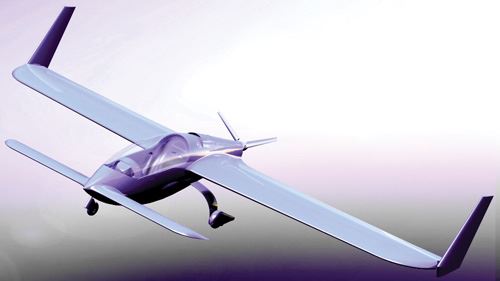Tooling block makes affordable patterns for new superlight aircraft
Tooling for a new canard-winged pusher airplane, the e-Go (e-Go Airplanes of Cambridge, U.K.), was created from patterns made of EP678 epoxy tooling block, supplied by the Advanced Engineering Materials Product Group of Trelleborg Offshore UK (Skelmersdale, Lancashire, U.K.)
When the Popular Flying Assn. (PFA), now the Light Aircraft Assn. (LAA, Turweston Aerodrome, Brackley, U.K.), launched a competition in 2007 for new designs that would meet the limited rules for the U.K.’s Single-Seat De-Regulated (SSDR) class of light aircraft, e-Go Airplanes (Cambridge, U.K.) jumped at the chance, according to e-Go’s CEO, Tony Bishop. The resulting canard-winged pusher airplane, the e-Go, was designed using SolidWorks 3-D CAD software (Dassault Systèmes, Waltham, Mass.) to be fuel-efficient, easy to fly and ergonomic. When the startup company’s design won the competition, e-Go was overwhelmed with demand for aircraft.
Composites were a must for the e-Go, which according to SSDR rules must have an empty weight (including engine) of less than 115 kg/253 lb. The Advanced Engineering Materials Product Group of Trelleborg Offshore UK (Skelmersdale, Lancashire, U.K.) sponsored the e-Go project by providing its high-temperature EP678 epoxy tooling block to make the patterns for all of the composite tools. The material has a density of 44 lb/ft3 (708 kg/m3), a heat distortion temperature of nearly 250°F/119°C and a relatively low coefficient of thermal expansion (CTE).
“Trelleborg generously provided half-size boards of its EP678 tooling block to make the patterns for all the composite work. We required accurately machined patterns with an excellent surface finish and temperature stability as we have to be able to make the composite components quickly, efficiently and with an excellent finish,” says Bishop. “Trelleborg’s epoxy block was ideal for this.”
The program has reached the prototype phase, and patterns are currently being CNC-machined at a number of shops, including Core Composites (Brackley, Northamptonshire, U.K.). Molds and parts will be built at the e-Go Centre with carbon fiber and glass fiber prepreg materials. For example, the nose cone is made with fiberglass prepreg and cored with Diab International AB (Laholm, Sweden) Divinycell foam core. The first flight of the prototype e-Go is planned for mid-2012, and production is expected to commence soon after.
Related Content
-
ASCEND program update: Designing next-gen, high-rate auto and aerospace composites
GKN Aerospace, McLaren Automotive and U.K.-based partners share goals and progress aiming at high-rate, Industry 4.0-enabled, sustainable materials and processes.
-
Active core molding: A new way to make composite parts
Koridion expandable material is combined with induction-heated molds to make high-quality, complex-shaped parts in minutes with 40% less material and 90% less energy, unlocking new possibilities in design and production.
-
Bladder-assisted compression molding derivative produces complex, autoclave-quality automotive parts
HP Composites’ AirPower technology enables high-rate CFRP roof production with 50% energy savings for the Maserati MC20.















